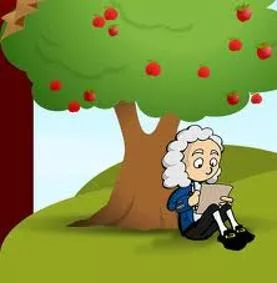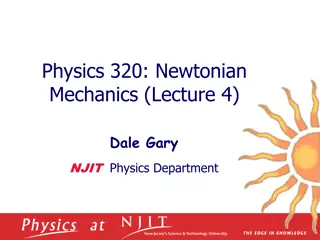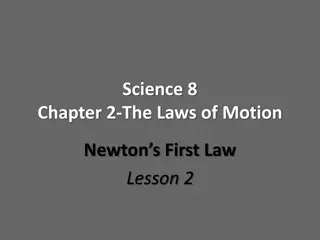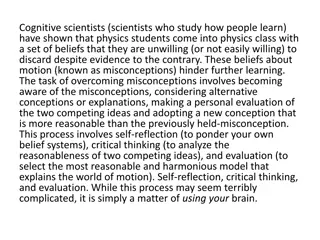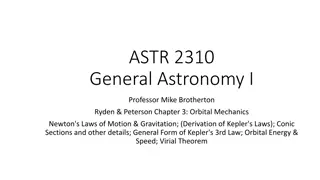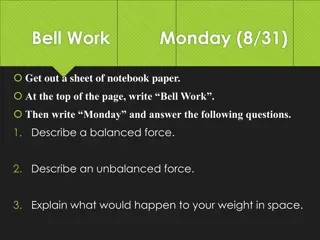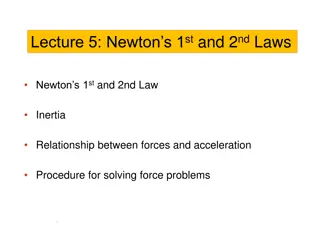Understanding Newton's Laws of Motion and Forces in Physics
Explore the foundational principles of physics through Sir Isaac Newton's Laws of Motion, gravitational force, and the concept of forces. Discover how these concepts shape our understanding of motion and interactions in the universe.
Download Presentation

Please find below an Image/Link to download the presentation.
The content on the website is provided AS IS for your information and personal use only. It may not be sold, licensed, or shared on other websites without obtaining consent from the author. Download presentation by click this link. If you encounter any issues during the download, it is possible that the publisher has removed the file from their server.
E N D
Presentation Transcript
DELTA ACADEMY EGG DROP PHYSICS BALENA SHORTER Delta Sigma Theta Sorority Inc. Cincinnati Alumnae Chapter 1 7/16/2024
TOPICS Sir Isaac Newton - Newton s Laws of Motion Forces Gravity, Mass, and Weight Acceleration and Velocity Rates of falling objects Egg Drop ideas and tips 2 7/16/2024
WHO WAS SIR ISAAC NEWTON Sir Isaac Newton is recognized as being one of the most influential scientist of all time. Sir Isaac Newton s largest contributions were in the areas of science and mathematics. Newton discovered many of the laws and theories that not only furthered our understanding of the universe, but also gave future scientists the tools to discover how to enter space. He discovered gravitational force and established the three Universal Laws of Motion. He supposedly discovered gravitational force after being hit on the head by a falling apple. 3 7/16/2024
NEWTONS LAWS OF MOTION A body will remain at rest or motion unless acted upon by an external force (Inertia) Newton s 1st Law The forces acting on a body is equal to mass times acceleration (F=ma) Newton s 2nd Law For every action there is always an opposite and equal reaction Newton s 3rd Law 4 7/16/2024
WHAT IS A FORCE A force is a push or pull upon an object resulting from the object's interaction with another object. Whenever there is an interaction between two objects, there is a force upon each of the objects. When the interaction ceases, the two objects no longer experience the force. Forces only exist as a result of an interaction. 5 7/16/2024
FORCE DIAGRAMS 6 7/16/2024
TYPES OF FORCE SYSTEMS Weight of an object Tension Forces (pull) F=m*a W=m*g Magnetic Force F =qv x B 7 7/16/2024
GRAVITY The force of gravity is the force with which the earth, moon, or other massively large object attracts another object towards itself. By definition, this is the weight of the object. All objects upon earth experience a force of gravity that is directed "downward" towards the center of the earth. The force of gravity on earth is always equal to the weight of the object as found by the equation: Fgravity= m * g, where g = 9.8 m/s2 (on Earth) m = mass (in kg) Note: All objects fall at the same gravitational rate 8 7/16/2024
WEIGHT VS. MASS Weight The weight of a body is the gravitational force exerted on it by the earth Weight is a vector quantity Weight is a force Weights direction is toward the center of the earth Weight is measured in force units such as lbs or Newtons Mass Mass is the amount of matter an object contains It is a scalar quantity measured in kilograms typically Mass is not directional Mass does not change with gravity 9 7/16/2024
WEIGHT VS. MASS CONT. An object with a mass of 1.0 kilogram will weigh approximately 9.81 newtons (newton is the unit of force kilogram is the unit of mass) on the surface of the Earth (its mass multiplied by the gravitational field strength). Its weight will be less on Mars (where gravity is weaker), more on Saturn (where gravity is stronger), but it will always have the same mass. 10 7/16/2024
VELOCITY Velocity vector quantity that refers to "the rate at which an object changes its position. It is defined algebraically as Distance divided by time If a train moved from locations A to B and the time that it took to move from locations A and B are known, then the velocity can be determined. Velocity and speed are different Speed does not have direction, it has magnitude only Velocity has units such as ft/s, m/s, miles/hour(mph) . 11 7/16/2024
ACCELERATION Acceleration is a vector quantity that is defined as the rate at which an object changes its velocity. An object is accelerating if it is changing its velocity. If an object is not changing its velocity, then the object is not accelerating even if it is going fast Acceleration is defined mathematically as A=velocity/time, where A = acceleration Units are typically m/s2 , ft/s2 Note: Acceleration is change in velocity 12 7/16/2024
HOW TO CREATE PARACHUTES FOR YOUR EGG DROPS 13 7/16/2024
EGG DROP IDEAS 14 7/16/2024
EGG DROP IDEAS 15 7/16/2024
EGG DROP VEHICLE TIPS Create a sketch of your proposed design Create a basket or shell for the egg. This can be done with straws or cardboard. Surround the egg with shock absorbing materials, i.e., bubble wrap, cotton balls, felt cloth, plastic bags. When using rubber bands, make sure the connections are tight and secure. Inflated balloons, fans, and parachutes can slow the eggs descent or fall by creating air resistance. If you re using straws, cut the lengths equally 1. 2. 3. 4. 5. 6. 16 7/16/2024
APPENDIX Additional topics for enhanced study (Optional) 7/16/2024 17
KINETIC AND POTENTIAL ENERGY Potential Energy is the work done in lifting an object through a height h(ft, inch,..etc) Potential Energy is the product of mass * gravity* height or m*g*h. P.E. = mgh Kinetic Energy of an object is the energy which it possesses due to its motion The kinetic energy is equal to the mass multiplied by the square of the speed, multiplied by the constant K.E. = *m*v2 where m = mass Bonus: How does the height at which the eggs are dropped relate to potential energy and momentum? where v= velocity 18 7/16/2024
KINETIC AND POTENTIAL ENERGY 19 7/16/2024
MOMENTUM Momentum is the product of mass times velocity Momentum is a directional entity Momentum increases when either mass or velocity increase, it is proportional P = m*V Where P = Momentum m = mass V= velocitiy 20 7/16/2024
DRAG Drag is a type of force, specifically it is air resistance force It is frictional and directional Acts upon objects as they travel through the air. The force of air resistance acts to oppose the motion of an object Note the directionality of the forces. Force must have direction in order to balance the loads on a system Lift acts opposite of the Weight which always acts downward towards the center of the earth Drag acts opposite of Thrust 21 7/16/2024







